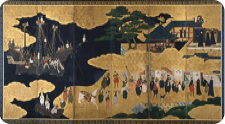Project Responsible: Dr. Lucio Sousa (Tokyo University of Foreign Studies)
Project funded by Japan Foundation for the Promotion of Science (JSPS)
1. The Jewish diaspora into Asian port cities and their networks
On the basis of a variety of documented evidence, we intend to trace the Sephardic diaspora from the Mediterranean Sea to East Asia (including Japan) and its consequent expansion via the Pacific Ocean to America. The newly published study of Lucio de Sousa- The Early European Presence in China, Japan, the Philippines and Southeast Asia (1550-1590) shows that the early European presence in Ming China had a strong Jewish undercurrent which drifted from the Iberian Peninsula for the inquisition. Around 1570, almost fifty percent of the European population living in Macao was of Jewish extraction (including conversos). This fact is of great significance, since it proves that the Jewish Diaspora contributed towards the creation of a well-connected trade network between Europe and Asia. These Jewish merchants, historically under-estimated and ignored, were to play a very important economic role in Asia, developing the commerce between Macao and Japan and providing financial and military assistance to Jesuits in Kyushu. For example, in 1582, they opened the trade between Macau and Manila, and in 1583, between Manila and Japan. Instead of concentrating on the commerce in China and Japan, they tried to open commercial lines between China and America (Macao-Acapulco). In 1580s, the Europeans of Jewish origin tried to negotiate with the Chinese authorities towards obtaining a place in Macau where they could erect a synagogue.
The Jewish presence in Asia—especially in the area between China and America—reached its peak in the late sixteenth century. It declined during the seventeenth century, partly due to the religious persecution of the leading Europeans merchants as well as the confiscation of their properties. When we traced the origin of these traders, we discovered that many contacts had been made through the Ottoman Empire (the greatest patron of Sephardim) with India and Macao as well as between China and America (via the Pacific Ocean). These contacts, as well as trade routes, cargo and commercial agents are completely unknown aspects which demonstrate the flexibility and range of links between the Islamic and Christian worlds, and the importance of this Jewish presence in transmitting secret information, building alliances and expanding or diversifying investments. The study of these merchants also reveals the presence of important Euro-Asian partnerships. An example of the same would be the commercial carracks connecting Macau and Nagasaki. These ships represented genuine economic partnerships not only between the Europeans, but also between the European traders and the local merchants in Asia.
2. The slave trade run by Europeans in Asia
Namely, we aim at analysing the main European mercantile communities involved in human trafficking; proving the existence of an important slave distribution centre in Macao, which has so far been ignored; clarifying the development of slave networks and their expansion through China to Europe and America; and tracing the lives of some of these slaves and the destinations they were forcibly taken to. In Asia, slavery played a very important economic role in the financing and expansion of European trade. The purchase and sale of slaves and their employment in ships, houses and private armies was extraordinary. Among the many examples, perhaps the most astonishing and unpublished account of this period was that of a Chinese female slave named Vitoria Diaz (152-page manuscript). She was captured in China, after which she was taken to Japan, Malacca, Cochin, Goa, Lisbon, and finally, to Antwerp.

Jewish Diasporas and Slave Trade Networks in Europe and Asia